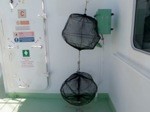
Check Lists – Just Who is Checking? - Check Lists - Just Who is Checking?
Initial Report
CHIRP received three reports of hazardous occurrences; each of these would have been avoided if the Bridge team had completed their own onboard checklists in a vigilant manner and not adopted a ‘tick box’ mentality to their own inspection routines.
A) The ship’s bell had been missing for several months but it was only noticed when the ship was preparing for a tanker vetting inspection. Without the ship’s bell the vessel is unable to comply with International Regulations for Preventing Collision at Sea 1972 (COLREGS) Rule 33 Sound Signals in Restricted visibility. The hand over between second officers did not include a comprehensive check of all equipment required by the COLREGs, similarly pre sailing checks and internal bridge audits failed to identify the missing equipment. The bell was later found, but only after a crewmember admitted to hiding the bell, with the intention of removing it from the ship.

B) An incoming Captain’s inspection found the Navigation shape for a ‘vessel not under command’ was incorrectly made. The two black balls had a vertical distance apart of 0.40 metres and not at least 1.5 metres as required by the COLREGS Annex 1.6.
C) The off course alarm used when steering with the automatic pilot had been switched off for nine months. The fault first occurred after the liquid in the magnetic compass was replaced. The alarm sounded at all times and was routinely cancelled by each OOW; nobody read the instruction manual to find out how to correct the fault. The incoming Master read the manual and soon identified the fault; the sensor light had been fitted 180 degrees out of line.
CHIRP Comment
The danger of not identifying the cause of equipment malfunctions and therefore unwilling to fix the problem, or not making good damaged or missing navigation equipment, cannot be understated. Pre-sailing checks of the bridge equipment and the internal bridge safety audits are put in place for very valid reasons. Seafarers should be aware; adopting a ‘tick box’ approach to safety checks carries a high risk to the safety of all onboard the ship.
It is suggested that a formal system of recorded follow up to any identified issues from pre sailing checks is put in place. In addition, a comprehensive cross check of all bridge equipment should be carried out on a regular basis, by another officer to those carrying out pre sailing checks, to provide for a level of backup to avoid complacency.